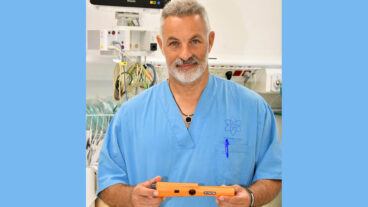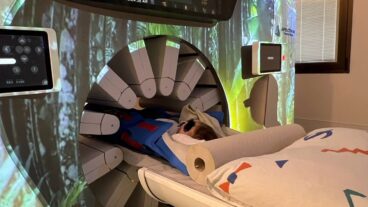The Virtual Patient Engine provides a safe, virtual, cheaper and quicker way to test how a new drug will work in humans.The development of any new drug for cancer – which kills half a million Americans every year – is a lengthy, expensive process. Drugs that seem promising in animal tests may turn out to be ineffective in humans, and can often put human subjects at risk during the testing.
The Virtual Patient Engine – developed by Israeli company Optimata – removes the risk, providing a safe, virtual, cheaper and quicker way to test how a new drug will work in humans. In a pilot project, Optimata is collaborating with multinational pharmaceutical company Eli Lilly to design clinical trials of a new anti-cancer drug.
“We are helping Eli Lilly throughout the development of a new anti-cancer cytotoxic compound,” explains Optimata CEO Guy Malchi, who was brought in to head the Ramat Gan- based company just over a year ago, after spending seven years in the UK running the European Life Science Practice of Israeli consulting firm Tefen.
Optimata was founded in 1999 by Professor Zvia Agur, now the company’s chairperson and chief scientific officer. Agur is a biomathematician and founder of the Institute for Medical Biomathematics, a new discipline which combines mathematics and biology for medical purposes. Simply put, Agur and her team created software that models the body’s biological processes.
Cancer is the company’s current focus. Certain processes are highly relevant to cancer patients, such as the creation of new blood vessels. While all of us have the same basic mechanism for making new blood vessels, the rate at which they are created differs from person to person – which is vital for cancer, because a tumor needs new blood vessels in order to grow. The characteristics of a cancerous tumor also vary from patient to patient, so putting all patients on the same therapeutic regime just doesn’t make sense.
The Virtual Patient Engine (VPE) takes the data collected from tests on an individual patient and then creates a virtual “clone” of that patient. This clone is used to personalize the cancer treatment, simulating the patient’s response to therapy in various situations in which differing amounts of treatment are given at different points in the patient’s cycle of blood vessel growth, for example, to find the best timing and dosage for each patient. Animal tests of the Virtual Patient Engine showed that this not only helps make treatment more effective but can also reduce the amount of drug necessary, easing the often-debilitating side effects. A trial of the Virtual Patient Engine (VPE) with breast cancer patients at the UK’s Nottingham City Hospital has just ended and Malchi estimates that the results will be available in June.
Personalizing treatment is just one aspect of Optimata’s work. The collaboration with Eli Lilly will show, hopes Malchi, how the VPE can help design the best way to test a drug in clinical trials.
“Eli Lilly already had the Phase I trial results,” which tested what was a safe dosage for humans, but the company didn’t show Optimata the results, instead testing the VPE’s powers by asking the company to predict what the outcome of the Phase I trial was. “We passed this test successfully,” he told ISRAEL21c, “and now they want us to predict what clinical indication they should go into for Phase II trials.”
Lilly’s new compound is aimed at cancerous tumors, but what should it be tested on: breast cancer, prostate cancer or one of the other 200 hundred or so types of cancer? Finding the right type of cancer to test the compound on can be the make-or-break decision for clinical trials. Test it on the wrong cancer and a drug that might be highly effective on prostate tumors, say, might be abandoned without realizing its potential.
Another use of the VPE is to divide a patient population of, say, breast cancer sufferers, into smaller sub-groups with particular characteristics which may affect their response to treatment. This can help a pharmaceutical company predict which groups of patients would benefit the most from a particular drug, or how best to structure a treatment regime for a particular sub-group.
The VPE can also assist in “drug salvage”: rehabilitating a drug that may have gotten “stuck” during the clinical trials process, appearing not to be working for a particular disease or patient group. “We can help them find a different regimen or patient population,” says Malchi. “This could also be ‘drug re-purposing’ – companies are starting to look at their old archives and seeing if they can find a new clinical application [for an old drug]. We can definitely do it virtually.”
Unlike the handful of other companies in the “predictive biosimulation” field, Optimata, which currently has 15 employees, is focusing solely on cancer, building its expertise in all types of tumors, running clinical trials and publishing results in clinical journals in order to demonstrate to clients that Optimata is not simply a software company. “We don’t want to come across as computer geeks, we want to come across as a company that really understands the clinical pathways of cancer etc…” explains Malchi. However, in the future, Optimata will expand into other areas. “The product is generic,” says Malchi.
Optimata is running its European operations from Israel, and Malchi is planning to open an office in the US at the beginning of next year. The company already has an American collaboration in the field of personalized medicine, but Malchi declines to go into details at this stage. In parallel to trials and pilot collaborations, Optimata’s R&D team continues to refine the engine. “We have to keep up to speed with the market,” says Malchi. “There are always news drugs and new types of mechanisms, and we have to make sure our model fits. [For example,] we are planning to develop the capability to model cancer vaccines.” Another possibility for the future is to make the software web-based.
Optimata is not simply selling technology; Malchi sees the company as providing a service in which the company and the client are partners. “I am pleased to see the level of interaction we have with Eli Lilly,” he says. “They don’t just give us all their data and sit back. We speak to them on a weekly basis. We are a novel technology and they need to believe in it.”












